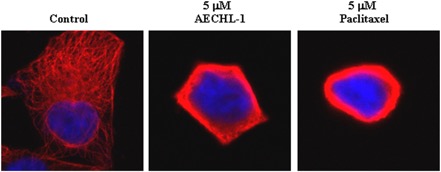In a quest to find therapeutic molecules having high specificity for cancerous cells and fewer side effects than existing chemotherapeutic agents, scientists at NCCS have identified and isolated a novel triterpenoid AECHL-1. This molecule is currently being developed as a chemotherapeutic agent for breast cancer. It has a novel mechanism of action through disruption of microtubules and targeting the mitochondria of the cancer cells without affecting normal epithelial cells.
Figure 1: Effect of AECHL-1 on microtubules. MCF-7 cells were treated with the vehicle as a control, AECHL-1 (5 mM) and paclitaxel (5 mM) as a positive control for 24 h, and microtubules (red) were visualized by indirect immunofluorescence. DAPI was used to stain the cell nuclei (blue). Representative of 25–30 cells each in 3 separate experiments.
AECHL-1 is less toxic, more selective and efficacious than Paclitaxel and Cisplatin. Further studies have shown that it has anti-angiogenic property, i.e., it inhibits micro vascularization, with little or no toxicity to normal HUVECs. This patented molecule is isolated from the root bark of Ailanthus Excelsa Roxb, also known as tree of heaven, which is widely distributed in the asian countries like India, China, Malaysia, Japan and Australia.
Technology Readiness Level: TRL B3
Technology Status: PCT filed (PCT/INO8/000795), Patented in India and Granted in USA (8,519,163 B2), EU (2337782) and Japan (5468611).
Technology Availability: Know-how available for technology transfer and/or co-development.
References:
- A Novel Triterpenoid Isolated from the Root Bark of Ailanthus excelsa Roxb (Tree of Heaven),AECHL-1 as a Potential Anti-Cancer Agent, PloS One Apr 2009, Vol 4:4 (Article).
- AECHL-1, a novel triterpenoid, targets tumor neo-vasculature and impairs the endothelial cell cytoskeleton, Angiogenesis 2015 18:283–299 (Article).
- Novel triterpenoid AECHL-1 induces apoptosis in breast cancer cells by perturbing the mitochondria-endoplasmic reticulum interactions and targeting diverse apoptotic pathways. Biochim Biophys Acta. 2016 Feb 3. pii: S0304-4165(16)30015-0 (Article).

